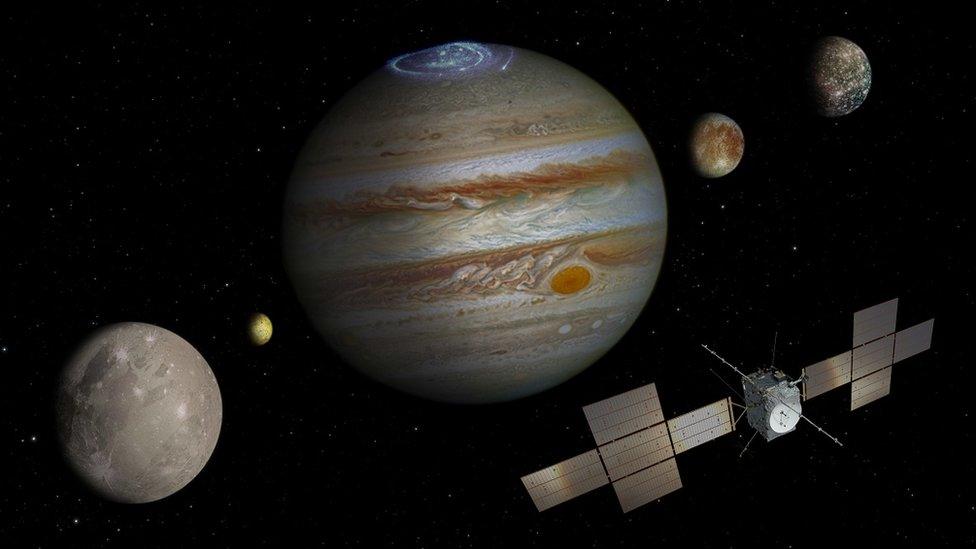Juice spacecraft: Mission to Jupiter and its moons delayed by bad weather
- Published
- comments

The European Space Agency's mission to Jupiter - due to take off from French Guiana to Jupiter - has been postponed until Friday due to bad weather.
The aim of the mission is to find out more about the giant planet's three icy moons.
There is good evidence that these icy worlds - Callisto, Europa and Ganymede - hold oceans of liquid water at depth.
The spacecraft, which is called the Jupiter Icy Moons Explorer - or Juice - for short, was developed as part of a £1.4 billion space project.
How will Juice get to Jupiter and what will it do?
Italian astronomer Galileo Galilei identified Jupiter's four major moons in 1610. Only Io (top) will not be visited by Juice
It'll take about eight years for the probe to reach Jupiter, meaning it's not due to get to the planet until July 2031.
The spacecraft will play a key role in analysing the oceans beneath the icy crusts of Jupiter's largest moon, Ganymede, over eight months.
It'll also explore Jupiter's other moons, Europa and Callisto.
Juice will perform 35 close passes of the moons - getting to within 400km of their surfaces on occasion - before settling into orbit around Ganymede.
The data, which will be collected by Juice's range of instruments, will help determine the depth and salt content of Ganymede's ocean, to see if it may hold the conditions for life.
Looking for signs of life in space
The development of the probe is part of a £1.4 billion project
Earth has shown scientists that for life to develop you need four essential things: liquid water, nutrients of some kind, an energy source, and time - an extended period of stability during which biology can get a foothold and establish itself.
Mars has long been thought of as the most likely candidate to host extra-terrestrial life, if not today then sometime in its distant past.
But for astrobiologists - scientists who study the possibility of life elsewhere in the Universe - the ice covered moons of Jupiter and also Saturn are really starting to look interesting.
Jupiter is believed to have the most moons of any planet in our solar system, with the number currently standing at 92. It's after the recent discovery of 12 new moons. It's now taken the record from Saturn which has 83 moons.
Artwork: The US space agency will launch the Clipper spacecraft next year
"With our instrument's measurements, we are almost looking inside these worlds," said Professor Michele Dougherty who is the head of the Department of Physics at Imperial College London and principal investigator for J-MAG.
"What we're doing however is extremely difficult, as the signals we're trying to detect are extremely small.
"It's like trying to find lots of needles in a haystack, and those needles are changing shape and colour all the time.
"But we think the results are going to be spectacular."
When are Nasa going to Jupiter?
The six-tonne probe will be heading towards the solar system's biggest planet carrying 10 scientific instruments
Juice isn't the only spacecraft set to make it's way to Jupiter this year - NASA's Europa Clipper mission is scheduled to launch in October.
The spacecraft, which will focus on Jupiter's moon Europa, will take a quicker path to Jupiter, arriving in April 2030.
- Published4 February 2023
- Published2 May 2012
- Published21 January 2023
